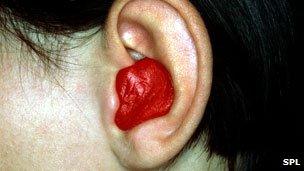'Glue ear' treatment could see 'end to grommet surgery'
- Published

Scientists have identified a potential new treatment for "glue ear" - a common hearing disorder in children - that uses existing cancer drugs.
Writing in PLoS Genetics, researchers from the Medical Research Council found that these drugs relieved the symptoms of persistent ear inflammation in mice.
They say the discovery could lead to an alternative to grommet surgery for many children.
A hearing loss charity said it was an important step towards a new treatment.
The study says that several existing drugs currently used in cancer treatment, known as VEGF inhibitors, can tackle the root causes of 'glue ear'.
Prof Steve Brown, director of the MRC mammalian genetics unit at the Medical Research Council and lead study researcher, said that a lack of oxygen reaching the middle ear was a key factor in the development of the condition.
"This lack of oxygen, known as hypoxia, appears to prevent the inflammation in the middle ear resolving, allowing fluid to build up, which can impair hearing.
"By using existing drugs that tackle the root causes of hypoxia, we have been able to significantly reduce hearing loss and the build-up of fluid in the middle ear of our mouse models."
Non-invasive
The researchers say they want to "repurpose" the cancer drugs into a treatment which can be delivered directly into the ear at the area of inflammation.
They claim this will help to eliminate any potential side-effects of the drugs.
"The next stage involves looking in more detail at how to apply this in humans and children," Professor Brown said.
"We wouldn't normally want to give anti-cancer drugs to children, but the middle ear is relatively accessible and a GP could put a patch directly on the membrane in the middle ear."
He also said it would be a non-invasive, non-surgical treatment.
Currently, NICE recommends grommets or hearing aids as effective treatments for glue ear which does not clear up over time.
Grommets are tiny plastic tubes which are put into the eardrum to improve ventilation during a short operation under general anaesthetic.
Around 30,000 grommet insertions are carried out each year in the UK.
'Ground-breaking'
Dr Ian Williamson, senior lecturer in general practice at the University of Southampton, expert in the field of otitis media and adviser to Deafness Research UK, said the study was a considerable scientific advance.
"By developing genetic disease models for glue ear, the research team have gained new insights into potential ways of identifying children at risk.
"Although the results published today are clearly ground-breaking, carefully controlled clinical trials would be needed before any new treatments would be available in the clinic or doctors surgery."
Vicki Kirwin, audiologist with the National Deaf Children's Society, said they also welcomed the research.
"This research is at a very early stage, but we welcome all medical discoveries which contribute to a greater and more positive understanding of deafness and which will give families more choice in support and treatment.
"Eight out of 10 children will have experienced glue ear at least once before they reach the age of 10. Although it's a common condition, it can have a big impact.
"If a child has glue ear for a long time, it can affect their speech and language development, they may fall behind at school and can even become disruptive if they don't get extra support."
Dr Ralph Holme, head of biomedical research at Action on Hearing Loss, said: "This research is an important step towards an effective pharmacological treatment for this common and distressing condition."
The research was carried out by the MRC Mammalian Genetics Unit, the Mary Lyon Centre at Harwell and the University of Oxford.
- Published13 August 2010
- Published10 April 2009
- Published22 February 2009